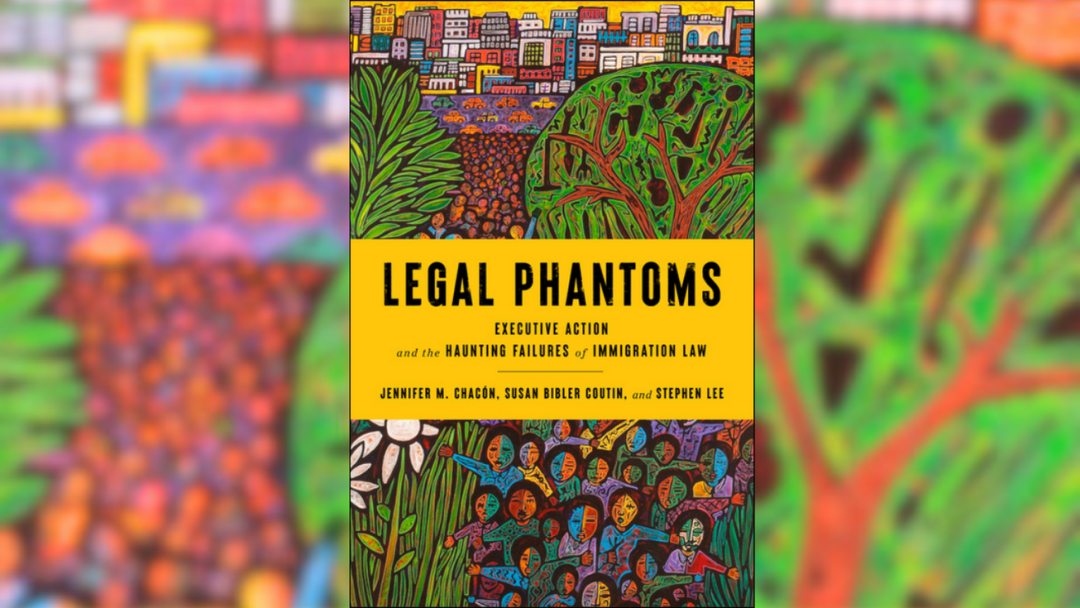
‘Legal Phantoms’ co-authored by Susan Bibler Coutin
Legal Phantoms: Executive Action and the Haunting Failures of Immigration Law, a new book published by Stanford University Press tells the story of the nation’s Deferred Action programs, including Deferred Action for Parents of Americans (DAPA) announced by President Obama in 2014 and enjoined by the Courts in 2015. DAPA, which would have allowed almost half of the undocumented population in the United States to gain temporary work authorization, was never implemented.
“The 2012 Deferred Action for Childhood Arrivals (DACA) program was supposed to be a stepping stone, a policy innovation announced by the White House designed to put pressure on Congress for a broader, lasting set of legislative changes,” according to the book jacket. “Those changes never materialized, and the people who hoped to benefit from them have been forced to navigate a tense and contradictory policy landscape ever since, haunted by these unfulfilled promises.”
The book is co-authored by Susan Bibler Coutin, UC Irvine professor of criminology, law and society; Jennifer M. Chacón, the Bruce Tyson Mitchell professor of law at Stanford; and Stephen Lee, UCI professor of law. Sameer Ashar, professor of law at UCI, is co-author of two chapters.
“We wrote this book because we wanted to document the experiences of long-time immigrant residents of the United States who were promised opportunities that then vanished, as well as the attorneys, organizers, and activists who had geared up to support them,” Coutin says. “The story of DAPA illuminates the dynamics of immigration policy-making, in which enforcement efforts that cause harm frequently take precedence over immigration relief that would improve the quality of life for many.”
The book uplifts the visions for inclusion that were articulated by immigrant community members and advocates, including minimizing distinctions based on immigration status, expanding opportunities for relief, and creating remedies that are permanent rather than temporary.
“Working on this book was a tremendous opportunity to collaborate with my colleagues Jennifer, Stephen and Sameer, the many student research assistants who supported the project, and the organizations and community members who participated in the study,” Coutin says. “We crossed boundaries between legal scholarship and social sciences, Orange and LA counties, advocates and government officials, and API and Latinx immigrant rights organizations. It was exciting to carry out the research and to write the book!”
An excerpt:
On Nov. 20, 2014, President Obama went on national television to announce Deferred Action for Parents of Americans and Lawful Permanent Residents (DAPA) and an expansion of the 2012 Deferred Action for Childhood Arrivals (DACA) program (DACA+). …
Ultimately, DAPA and DACA+ ended before they began. On February 16, 2015, just days before the programs were set to go into effect, a federal district court in Texas issued a nationwide preliminary injunction preventing them from being implemented while litigation on the merits of the programs proceeded. As the litigation wore on, the programs remained frozen in the courts. In 2017, Donald J. Trump assumed the presidency after running on a racist, anti-immigrant platform. Unsurprisingly, his administration rescinded DAPA and DACA+ altogether. President Obama’s “deal” never came to pass, but it has left traces everywhere—a phantom program that continues to haunt. …
This is a book about the interstitial space connecting these landmark political and legal moments over a ten-year period, from 2012 to 2022. Our 135 interviews and focus group sessions with immigrants, community organizers and leaders, lawyers, and government officials document these years of political and legal uncertainty. We tell a story of government action gone awry, the continued immiseration of immigrants in limbo in the United States, and advocates and organizers navigating a shifting and complex terrain. We document the ways that people continue to be haunted by the failed promise of phantom DAPA and DACA+ programs, and the broader failures of immigration policy.
Ultimately, we tell a story about the limits of political imagination, sharply restricted by the central logic of US immigration law and policy as it has developed in the past century—a logic rooted in racism and manifested in discretionary, racialized enforcement. Even when government officials imagined themselves to be bold actors developing unprecedented programs of relief for undocumented immigrants, they were in fact operating within a narrow field circumscribed by the legal and political terms of the governing discourse of the day. In fact, officials’ most imaginative political thinking was directed not toward immigration relief, which in the end was limited to a relatively small set of beneficiaries, but rather toward enforcement measures that devastated communities within the US and markedly increased the militarization of the external border. The United States’ governing discourse allowed for the exercise of nearly unfettered enforcement authority, while it kept discussions about relief contained within narrowly established parameters.
Despite these developments, those directly affected by legal uncertainty—immigrants, immigrant justice advocates, and organizers—withstood the violence of state action (and inaction), drawing on deep reserves of material, spiritual, and intellectual resources. Advocates and organizers showed how policy discourse could be made elastic to accommodate new terms. They resisted legal violence and they argued strenuously for new political horizons of possibility for immigrants in the US. Not only did they argue for the DREAM Act, various deferred action programs, and other, more comprehensive legalization measures, they also argued against immigration and criminal law enforcement programs and practices that imperiled large swaths of society regardless of immigration status. Their transformative vision, rooted in an expansive political imagination, still has the potential to transform immigration law and policy in the wake of the devastation wrought by the Trump era and by decades of violent immigration enforcement. Over the course of this book, we recount these hopes and aspirations, and the context in which they were forged, as we tell the story of the phantom DAPA and DACA+ programs.
Contact:
Mimi Ko Cruz
Director of Communications
949-824-1278